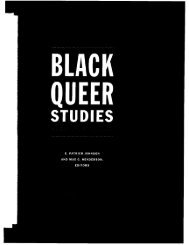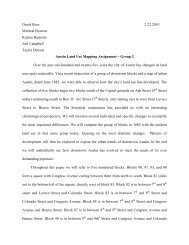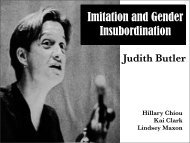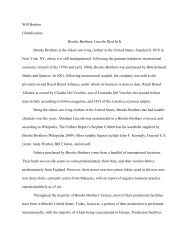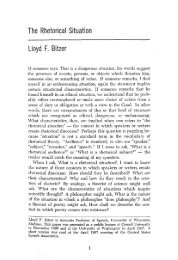Coherence, Cohesion, and Writing Quality Stephen P. Witte; Lester ...
Coherence, Cohesion, and Writing Quality Stephen P. Witte; Lester ...
Coherence, Cohesion, and Writing Quality Stephen P. Witte; Lester ...
Create successful ePaper yourself
Turn your PDF publications into a flip-book with our unique Google optimized e-Paper software.
College Composition <strong>and</strong> Communicationthe current context, what he knows about the world in general, <strong>and</strong> whathe assumes the speaker's intentions might be.16Hence lexical collocations within a text are understood through cues whichthe writer provides <strong>and</strong> through the reader's knowledge of general discoursecharacteristics <strong>and</strong> of the world to which the discourse refers.Thus lexical collocation is in all likelihood the subcategory of cohesion thatbest indicates overall writing ability, as well as disclosing distinctions amongwritten texts that represent different discourse modes <strong>and</strong> purposes. Anexamination of lexical cohesive ties shows how writers build ideas, how theyare able to take advantage of associations to weave together a text. But afundamental problem lies in the analysis of a writer's text. Whose collocationsdo we analyze-the reader's or the writer's? One simple proof that thetwo do not always coincide can be found in the unintentional sexual referencesthat students occasionally produce-the kind that get passed aroundthe faculty coffee room.Consider again the mountaineering guidebook passage in sentences (24),(25), <strong>and</strong> (26). We have already established that for mountaineers <strong>and</strong>glaciologists, bergschrund probably collocates with glacier, but for many otherpersons the two items do not collocate. Yet a naive reader presented this textprobably would not stop to consult a dictionary for the lexical item,bergschrzlnd, but would infer from its context that it is some type of obstacleto climbers <strong>and</strong> continue reading. Herbert Clark theorizes that we comprehendunknown items like bergschrzlnd by drawing inferences.17 We makeinferences on the basis of what we can gather from the explicit content <strong>and</strong>the circumstances surrounding a text, through a tacit contract between thewriter <strong>and</strong> reader that the writer will provide only information relevant to thecurrent topic. In the case of the mountaineering passage, the circumstancesof the text greatly affect our underst<strong>and</strong>ing of it. The type of text-aguidebook-follows a predictable organization, what has been called a scriptin research on artificial intelligence.18 The guidebook contains a series oftopics with a clear, yet implicit, goal: to inform the reader how to get to thetop of a mountain. We expect the author to give us only information relevantto the particular route. Accordingly, readers underst<strong>and</strong> bergschrzlnd as anobstacle through a combination of cues--overt signals in the text such as theparallelism of the bergschrund sentence with the sentence about crevassesabove it <strong>and</strong>, for those readers familiar with the type of text, implicit signalssuch as the following of the guidebook "script." Although Halliday <strong>and</strong>Hasan do not include parallelism in their taxonomy, parallelism often createsa cohesive tie.<strong>Cohesion</strong> <strong>and</strong> coherence interact to a great degree, but a cohesive text maybe only minimally coherent. Thus cohesion-based distinctions between textsrated high <strong>and</strong> low in quality can be misleading. Besides explicit links withina text, a text must conform to a reader's expectations for particular types oftexts <strong>and</strong> the reader's knowledge of the world. A simple example will illustratethis point:




